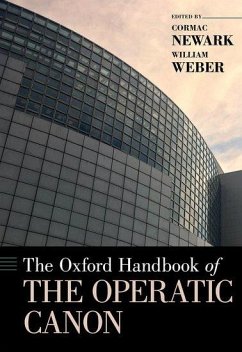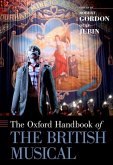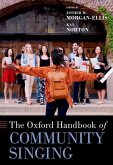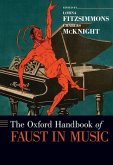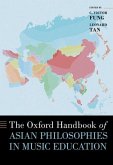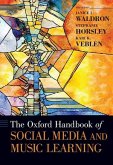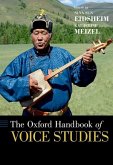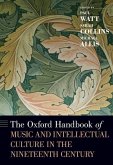The Oxford Handbook of the Operatic Canon
Herausgeber: Newark, Cormac; Weber, William
The Oxford Handbook of the Operatic Canon
Herausgeber: Newark, Cormac; Weber, William
- Gebundenes Buch
- Merkliste
- Auf die Merkliste
- Bewerten Bewerten
- Teilen
- Produkt teilen
- Produkterinnerung
- Produkterinnerung
The Oxford Handbook of the Operatic Canon examines how opera has become the concrete edifice it was never meant to be, by looking at how it evolved from a market entirely driven by novelty to one of the most arthritically canonic art forms still in existence.
Andere Kunden interessierten sich auch für
![Oxford Handbook of the British Musical Oxford Handbook of the British Musical]() Oxford Handbook of the British Musical263,99 €
Oxford Handbook of the British Musical263,99 €![The Oxford Handbook of Community Singing The Oxford Handbook of Community Singing]() The Oxford Handbook of Community Singing284,99 €
The Oxford Handbook of Community Singing284,99 €![The Oxford Handbook of Faust in Music The Oxford Handbook of Faust in Music]() The Oxford Handbook of Faust in Music209,99 €
The Oxford Handbook of Faust in Music209,99 €![The Oxford Handbook of Asian Philosophies in Music Education The Oxford Handbook of Asian Philosophies in Music Education]() The Oxford Handbook of Asian Philosophies in Music Education211,99 €
The Oxford Handbook of Asian Philosophies in Music Education211,99 €![The Oxford Handbook of Social Media and Music Learning The Oxford Handbook of Social Media and Music Learning]() The Oxford Handbook of Social Media and Music Learning241,99 €
The Oxford Handbook of Social Media and Music Learning241,99 €![The Oxford Handbook of Voice Studies The Oxford Handbook of Voice Studies]() The Oxford Handbook of Voice Studies209,99 €
The Oxford Handbook of Voice Studies209,99 €![Oxford Handbook of Music and Intellectual Culture in the Nineteenth Century Oxford Handbook of Music and Intellectual Culture in the Nineteenth Century]() Paul WattOxford Handbook of Music and Intellectual Culture in the Nineteenth Century232,99 €
Paul WattOxford Handbook of Music and Intellectual Culture in the Nineteenth Century232,99 €-
-
-
The Oxford Handbook of the Operatic Canon examines how opera has become the concrete edifice it was never meant to be, by looking at how it evolved from a market entirely driven by novelty to one of the most arthritically canonic art forms still in existence.
Hinweis: Dieser Artikel kann nur an eine deutsche Lieferadresse ausgeliefert werden.
Hinweis: Dieser Artikel kann nur an eine deutsche Lieferadresse ausgeliefert werden.
Produktdetails
- Produktdetails
- Verlag: Oxford University Press
- Seitenzahl: 640
- Erscheinungstermin: 2. Oktober 2020
- Englisch
- Abmessung: 254mm x 177mm x 48mm
- Gewicht: 1216g
- ISBN-13: 9780190224202
- ISBN-10: 0190224207
- Artikelnr.: 58306565
- Herstellerkennzeichnung
- Libri GmbH
- Europaallee 1
- 36244 Bad Hersfeld
- gpsr@libri.de
- Verlag: Oxford University Press
- Seitenzahl: 640
- Erscheinungstermin: 2. Oktober 2020
- Englisch
- Abmessung: 254mm x 177mm x 48mm
- Gewicht: 1216g
- ISBN-13: 9780190224202
- ISBN-10: 0190224207
- Artikelnr.: 58306565
- Herstellerkennzeichnung
- Libri GmbH
- Europaallee 1
- 36244 Bad Hersfeld
- gpsr@libri.de
Cormac Newark is Head of Research at the Guildhall School of Music & Drama in London. He writes mainly on nineteenth-century French and Italian opera and literature, and is the author of Opera in the Novel from Balzac to Proust. He has published articles in journals including 19th-Century Music , the Cambridge Opera Journal, The Opera Quarterly, and the Journal of the Royal Musical Association. William Weber is Professor of History, Emeritus at California State University, Long Beach. He has contributed to the Oxford Handbook of the New Cultural History of Music (OUP, 2011) and is the author of several books, including The Rise of Musical Classics in 18th-Century England (OUP, 1992) and The Great Transformation of Musical Taste: Concert Programming from Haydn to Brahms.
* Note to the reader
* Contributors
* Acknowledgements
* General Introduction
* Idiosyncrasies of the operatic canon
* Cormac Newark and William Weber
* Part 1. History, geography
* Introduction to Chapters 1 and 2
* Foundations: France and Italy in the eighteenth century
* Michel Noiray and Franco Piperno
* Chapater 1.The practical and symbolic functions of pre-Rameau opera
at the Paris Opéra before Gluck
* Michel Noiray
* Chapter 2.Italian opera and the concept of "canon" in the late
eighteenth century
* Franco Piperno
* Introduction to Chapters 3 and 4
* From royal authority to public taste in Berlin, 1740-1815
* John Mangum and Katherine Hambridge
* Chapter 3. The repertory of the Italian Court Opera in Berlin,
1740-1786
* John Mangum
* Chapter 4.Catching up and getting ahead: The opera house as temple of
art in Berlin c. 1800
* Katherine Hambridge
* Introduction to Chapters 5 and 6
* Operatic practices at the London Opera: Pasticcio to repertory to
canon?
* Michael Burden and Jennifer Hall-Witt
* Chapter 5.From recycled performances to repertoire at the King's
Theatre in London, 1705-1820
* Michael Burden
* Chapter 6. Repertory opera and canonic sensibility at the London
opera, 1820-1860
* Jennifer Hall-Witt
* Introduction to chapters 7 and 8
* From capital-city opera house to provincial theaters in France
* Patrick Taïeb, Sabine Teulon Lardic and Yannick Simon
* Chapter 7.The evolution of French opera repertories in provincial
theaters: Three epochs, 1770-1900
* Patrick Taïeb and Sabine Teulon Lardic
* Chapter 8. The mingling of opera genres: Canonic opera at the Théâtre
des Arts in Rouen, 1882-1897
* Yannick Simon
* Introduction to chapters 9 and 10
* The Italian opera world and its canons
* Carlotta Sorba and Jutta Toelle
* Chapter 9. Theaters, markets, and canonic implications in the Italian
opera system, 1820-1880
* Carlotta Sorba
* Chapter 10.Operatic canons and repertories in Italy around 1900
* Jutta Toelle
* Introduction to chapters 11 and 12
* Opera in the Western Hemisphere, 1811-1910: New York, Buenos Aires,
and Montevideo
* Karen Ahlquist and Benjamin Walton
* Chapter 11. International opera in nineteenth-century New York: Core
repertories and canonic values
* Karen Ahlquist
* Chapter 12. Canons of real and imagined opera: Buenos Aires and
Montevideo, 1810-1860
* Benjamin Walton
* Introduction to chapters 13 and 14
* Tension between national and cosmopolitan canons in England and
Russia
* William Weber and Rutger Helmers
* Chapter 13.The survival of English opera in nineteenth-century
concert life
* William Weber
* Chapter 14.National and international canons of opera in Tsarist
Russia
* Rutger Helmers
* Part 2. Other views, other canons
* Introduction to chapters 15 and 16
* Singers and the operatic canon
* Kimberley White and Hilary Poriss
* Chapter 15.Setting the standard: Singers, theater practices, and the
operatic canon in nineteenth-century France
* Kimberley White
* Chapter 16.Redefining the standard: Pauline Viardot and Gluck's
Orphée
* Hilary Poriss
* Introduction to chapters 17 and 18
* Uses of the operatic canon
* Cormac Newark and Mark Berry
* Chapter 17. Canons of the Risorgimento then and now
* Cormac Newark
* Chapter 18. "Blow the opera houses into the air": Wagner, Boulez, and
modernist canons
* Mark Berry
* Introduction to chapters 19 and 20
* Re-writing the operatic canon
* Flora Willson and William Gibbons
* Chapter 19.Phantoms at the Opéra: Meyerbeer and de-canonization
* Flora Willson
* Chapter 20. The uses and disadvantages of opera history: Unhistorical
thinking in fin-de-siècle Paris
* William Gibbons
* Introduction to chapters 21 and 22
* Contiguous genres: Operetta and American musicals
* Micaela Baranello and Raymond Knapp
* Chapter 21. Viennese operetta canon formation and the journey to
prestige
* Micaela Baranello
* Chapter 22.Canons of the American musical
* Raymond Knapp
* Introduction to chapters 23 and 24
* Twentieth-century reproductive technology and the operatic canon
* Karen Henson and Hugo Shirley
* Chapter 23. Sound recording and the operatic canon: Three "drops of
the needle"
* Karen Henson
* Chapter 24. Opera on film and the canon
* Hugo Shirley
* Introduction to chapters 25 and 26
* Views of the operatic canon from the industry
* John Rockwell and Kasper Holten
* Chapter 25. Critical reflections on the operatic canon
* John Rockwell
* Chapter 26. Inside and outside the operatic canon, on stage and in
the boardroom
* Kasper Holten
* Bibliography
* Contributors
* Acknowledgements
* General Introduction
* Idiosyncrasies of the operatic canon
* Cormac Newark and William Weber
* Part 1. History, geography
* Introduction to Chapters 1 and 2
* Foundations: France and Italy in the eighteenth century
* Michel Noiray and Franco Piperno
* Chapater 1.The practical and symbolic functions of pre-Rameau opera
at the Paris Opéra before Gluck
* Michel Noiray
* Chapter 2.Italian opera and the concept of "canon" in the late
eighteenth century
* Franco Piperno
* Introduction to Chapters 3 and 4
* From royal authority to public taste in Berlin, 1740-1815
* John Mangum and Katherine Hambridge
* Chapter 3. The repertory of the Italian Court Opera in Berlin,
1740-1786
* John Mangum
* Chapter 4.Catching up and getting ahead: The opera house as temple of
art in Berlin c. 1800
* Katherine Hambridge
* Introduction to Chapters 5 and 6
* Operatic practices at the London Opera: Pasticcio to repertory to
canon?
* Michael Burden and Jennifer Hall-Witt
* Chapter 5.From recycled performances to repertoire at the King's
Theatre in London, 1705-1820
* Michael Burden
* Chapter 6. Repertory opera and canonic sensibility at the London
opera, 1820-1860
* Jennifer Hall-Witt
* Introduction to chapters 7 and 8
* From capital-city opera house to provincial theaters in France
* Patrick Taïeb, Sabine Teulon Lardic and Yannick Simon
* Chapter 7.The evolution of French opera repertories in provincial
theaters: Three epochs, 1770-1900
* Patrick Taïeb and Sabine Teulon Lardic
* Chapter 8. The mingling of opera genres: Canonic opera at the Théâtre
des Arts in Rouen, 1882-1897
* Yannick Simon
* Introduction to chapters 9 and 10
* The Italian opera world and its canons
* Carlotta Sorba and Jutta Toelle
* Chapter 9. Theaters, markets, and canonic implications in the Italian
opera system, 1820-1880
* Carlotta Sorba
* Chapter 10.Operatic canons and repertories in Italy around 1900
* Jutta Toelle
* Introduction to chapters 11 and 12
* Opera in the Western Hemisphere, 1811-1910: New York, Buenos Aires,
and Montevideo
* Karen Ahlquist and Benjamin Walton
* Chapter 11. International opera in nineteenth-century New York: Core
repertories and canonic values
* Karen Ahlquist
* Chapter 12. Canons of real and imagined opera: Buenos Aires and
Montevideo, 1810-1860
* Benjamin Walton
* Introduction to chapters 13 and 14
* Tension between national and cosmopolitan canons in England and
Russia
* William Weber and Rutger Helmers
* Chapter 13.The survival of English opera in nineteenth-century
concert life
* William Weber
* Chapter 14.National and international canons of opera in Tsarist
Russia
* Rutger Helmers
* Part 2. Other views, other canons
* Introduction to chapters 15 and 16
* Singers and the operatic canon
* Kimberley White and Hilary Poriss
* Chapter 15.Setting the standard: Singers, theater practices, and the
operatic canon in nineteenth-century France
* Kimberley White
* Chapter 16.Redefining the standard: Pauline Viardot and Gluck's
Orphée
* Hilary Poriss
* Introduction to chapters 17 and 18
* Uses of the operatic canon
* Cormac Newark and Mark Berry
* Chapter 17. Canons of the Risorgimento then and now
* Cormac Newark
* Chapter 18. "Blow the opera houses into the air": Wagner, Boulez, and
modernist canons
* Mark Berry
* Introduction to chapters 19 and 20
* Re-writing the operatic canon
* Flora Willson and William Gibbons
* Chapter 19.Phantoms at the Opéra: Meyerbeer and de-canonization
* Flora Willson
* Chapter 20. The uses and disadvantages of opera history: Unhistorical
thinking in fin-de-siècle Paris
* William Gibbons
* Introduction to chapters 21 and 22
* Contiguous genres: Operetta and American musicals
* Micaela Baranello and Raymond Knapp
* Chapter 21. Viennese operetta canon formation and the journey to
prestige
* Micaela Baranello
* Chapter 22.Canons of the American musical
* Raymond Knapp
* Introduction to chapters 23 and 24
* Twentieth-century reproductive technology and the operatic canon
* Karen Henson and Hugo Shirley
* Chapter 23. Sound recording and the operatic canon: Three "drops of
the needle"
* Karen Henson
* Chapter 24. Opera on film and the canon
* Hugo Shirley
* Introduction to chapters 25 and 26
* Views of the operatic canon from the industry
* John Rockwell and Kasper Holten
* Chapter 25. Critical reflections on the operatic canon
* John Rockwell
* Chapter 26. Inside and outside the operatic canon, on stage and in
the boardroom
* Kasper Holten
* Bibliography
* Note to the reader
* Contributors
* Acknowledgements
* General Introduction
* Idiosyncrasies of the operatic canon
* Cormac Newark and William Weber
* Part 1. History, geography
* Introduction to Chapters 1 and 2
* Foundations: France and Italy in the eighteenth century
* Michel Noiray and Franco Piperno
* Chapater 1.The practical and symbolic functions of pre-Rameau opera
at the Paris Opéra before Gluck
* Michel Noiray
* Chapter 2.Italian opera and the concept of "canon" in the late
eighteenth century
* Franco Piperno
* Introduction to Chapters 3 and 4
* From royal authority to public taste in Berlin, 1740-1815
* John Mangum and Katherine Hambridge
* Chapter 3. The repertory of the Italian Court Opera in Berlin,
1740-1786
* John Mangum
* Chapter 4.Catching up and getting ahead: The opera house as temple of
art in Berlin c. 1800
* Katherine Hambridge
* Introduction to Chapters 5 and 6
* Operatic practices at the London Opera: Pasticcio to repertory to
canon?
* Michael Burden and Jennifer Hall-Witt
* Chapter 5.From recycled performances to repertoire at the King's
Theatre in London, 1705-1820
* Michael Burden
* Chapter 6. Repertory opera and canonic sensibility at the London
opera, 1820-1860
* Jennifer Hall-Witt
* Introduction to chapters 7 and 8
* From capital-city opera house to provincial theaters in France
* Patrick Taïeb, Sabine Teulon Lardic and Yannick Simon
* Chapter 7.The evolution of French opera repertories in provincial
theaters: Three epochs, 1770-1900
* Patrick Taïeb and Sabine Teulon Lardic
* Chapter 8. The mingling of opera genres: Canonic opera at the Théâtre
des Arts in Rouen, 1882-1897
* Yannick Simon
* Introduction to chapters 9 and 10
* The Italian opera world and its canons
* Carlotta Sorba and Jutta Toelle
* Chapter 9. Theaters, markets, and canonic implications in the Italian
opera system, 1820-1880
* Carlotta Sorba
* Chapter 10.Operatic canons and repertories in Italy around 1900
* Jutta Toelle
* Introduction to chapters 11 and 12
* Opera in the Western Hemisphere, 1811-1910: New York, Buenos Aires,
and Montevideo
* Karen Ahlquist and Benjamin Walton
* Chapter 11. International opera in nineteenth-century New York: Core
repertories and canonic values
* Karen Ahlquist
* Chapter 12. Canons of real and imagined opera: Buenos Aires and
Montevideo, 1810-1860
* Benjamin Walton
* Introduction to chapters 13 and 14
* Tension between national and cosmopolitan canons in England and
Russia
* William Weber and Rutger Helmers
* Chapter 13.The survival of English opera in nineteenth-century
concert life
* William Weber
* Chapter 14.National and international canons of opera in Tsarist
Russia
* Rutger Helmers
* Part 2. Other views, other canons
* Introduction to chapters 15 and 16
* Singers and the operatic canon
* Kimberley White and Hilary Poriss
* Chapter 15.Setting the standard: Singers, theater practices, and the
operatic canon in nineteenth-century France
* Kimberley White
* Chapter 16.Redefining the standard: Pauline Viardot and Gluck's
Orphée
* Hilary Poriss
* Introduction to chapters 17 and 18
* Uses of the operatic canon
* Cormac Newark and Mark Berry
* Chapter 17. Canons of the Risorgimento then and now
* Cormac Newark
* Chapter 18. "Blow the opera houses into the air": Wagner, Boulez, and
modernist canons
* Mark Berry
* Introduction to chapters 19 and 20
* Re-writing the operatic canon
* Flora Willson and William Gibbons
* Chapter 19.Phantoms at the Opéra: Meyerbeer and de-canonization
* Flora Willson
* Chapter 20. The uses and disadvantages of opera history: Unhistorical
thinking in fin-de-siècle Paris
* William Gibbons
* Introduction to chapters 21 and 22
* Contiguous genres: Operetta and American musicals
* Micaela Baranello and Raymond Knapp
* Chapter 21. Viennese operetta canon formation and the journey to
prestige
* Micaela Baranello
* Chapter 22.Canons of the American musical
* Raymond Knapp
* Introduction to chapters 23 and 24
* Twentieth-century reproductive technology and the operatic canon
* Karen Henson and Hugo Shirley
* Chapter 23. Sound recording and the operatic canon: Three "drops of
the needle"
* Karen Henson
* Chapter 24. Opera on film and the canon
* Hugo Shirley
* Introduction to chapters 25 and 26
* Views of the operatic canon from the industry
* John Rockwell and Kasper Holten
* Chapter 25. Critical reflections on the operatic canon
* John Rockwell
* Chapter 26. Inside and outside the operatic canon, on stage and in
the boardroom
* Kasper Holten
* Bibliography
* Contributors
* Acknowledgements
* General Introduction
* Idiosyncrasies of the operatic canon
* Cormac Newark and William Weber
* Part 1. History, geography
* Introduction to Chapters 1 and 2
* Foundations: France and Italy in the eighteenth century
* Michel Noiray and Franco Piperno
* Chapater 1.The practical and symbolic functions of pre-Rameau opera
at the Paris Opéra before Gluck
* Michel Noiray
* Chapter 2.Italian opera and the concept of "canon" in the late
eighteenth century
* Franco Piperno
* Introduction to Chapters 3 and 4
* From royal authority to public taste in Berlin, 1740-1815
* John Mangum and Katherine Hambridge
* Chapter 3. The repertory of the Italian Court Opera in Berlin,
1740-1786
* John Mangum
* Chapter 4.Catching up and getting ahead: The opera house as temple of
art in Berlin c. 1800
* Katherine Hambridge
* Introduction to Chapters 5 and 6
* Operatic practices at the London Opera: Pasticcio to repertory to
canon?
* Michael Burden and Jennifer Hall-Witt
* Chapter 5.From recycled performances to repertoire at the King's
Theatre in London, 1705-1820
* Michael Burden
* Chapter 6. Repertory opera and canonic sensibility at the London
opera, 1820-1860
* Jennifer Hall-Witt
* Introduction to chapters 7 and 8
* From capital-city opera house to provincial theaters in France
* Patrick Taïeb, Sabine Teulon Lardic and Yannick Simon
* Chapter 7.The evolution of French opera repertories in provincial
theaters: Three epochs, 1770-1900
* Patrick Taïeb and Sabine Teulon Lardic
* Chapter 8. The mingling of opera genres: Canonic opera at the Théâtre
des Arts in Rouen, 1882-1897
* Yannick Simon
* Introduction to chapters 9 and 10
* The Italian opera world and its canons
* Carlotta Sorba and Jutta Toelle
* Chapter 9. Theaters, markets, and canonic implications in the Italian
opera system, 1820-1880
* Carlotta Sorba
* Chapter 10.Operatic canons and repertories in Italy around 1900
* Jutta Toelle
* Introduction to chapters 11 and 12
* Opera in the Western Hemisphere, 1811-1910: New York, Buenos Aires,
and Montevideo
* Karen Ahlquist and Benjamin Walton
* Chapter 11. International opera in nineteenth-century New York: Core
repertories and canonic values
* Karen Ahlquist
* Chapter 12. Canons of real and imagined opera: Buenos Aires and
Montevideo, 1810-1860
* Benjamin Walton
* Introduction to chapters 13 and 14
* Tension between national and cosmopolitan canons in England and
Russia
* William Weber and Rutger Helmers
* Chapter 13.The survival of English opera in nineteenth-century
concert life
* William Weber
* Chapter 14.National and international canons of opera in Tsarist
Russia
* Rutger Helmers
* Part 2. Other views, other canons
* Introduction to chapters 15 and 16
* Singers and the operatic canon
* Kimberley White and Hilary Poriss
* Chapter 15.Setting the standard: Singers, theater practices, and the
operatic canon in nineteenth-century France
* Kimberley White
* Chapter 16.Redefining the standard: Pauline Viardot and Gluck's
Orphée
* Hilary Poriss
* Introduction to chapters 17 and 18
* Uses of the operatic canon
* Cormac Newark and Mark Berry
* Chapter 17. Canons of the Risorgimento then and now
* Cormac Newark
* Chapter 18. "Blow the opera houses into the air": Wagner, Boulez, and
modernist canons
* Mark Berry
* Introduction to chapters 19 and 20
* Re-writing the operatic canon
* Flora Willson and William Gibbons
* Chapter 19.Phantoms at the Opéra: Meyerbeer and de-canonization
* Flora Willson
* Chapter 20. The uses and disadvantages of opera history: Unhistorical
thinking in fin-de-siècle Paris
* William Gibbons
* Introduction to chapters 21 and 22
* Contiguous genres: Operetta and American musicals
* Micaela Baranello and Raymond Knapp
* Chapter 21. Viennese operetta canon formation and the journey to
prestige
* Micaela Baranello
* Chapter 22.Canons of the American musical
* Raymond Knapp
* Introduction to chapters 23 and 24
* Twentieth-century reproductive technology and the operatic canon
* Karen Henson and Hugo Shirley
* Chapter 23. Sound recording and the operatic canon: Three "drops of
the needle"
* Karen Henson
* Chapter 24. Opera on film and the canon
* Hugo Shirley
* Introduction to chapters 25 and 26
* Views of the operatic canon from the industry
* John Rockwell and Kasper Holten
* Chapter 25. Critical reflections on the operatic canon
* John Rockwell
* Chapter 26. Inside and outside the operatic canon, on stage and in
the boardroom
* Kasper Holten
* Bibliography

